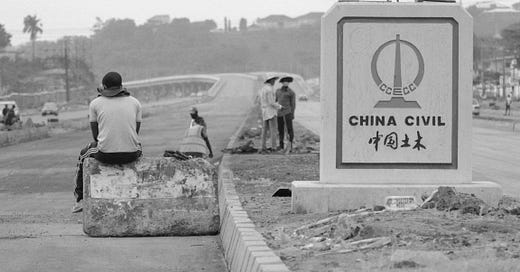In the middle of the photograph, two men stand beside each other. The lower halves of their faces are obscured by a mask. Another man sits with his back to the camera, and he is close enough to have the largest presence in the frame. Cars dot the three-laned highway, steadying along the even terrain. A block bears the name of the construction company, its logo, and underneath, a handful of Chinese letters. Farther above is a range of hills; the grey of the sky touches the black of trees and shrubbery. The scene seems quiet, but the men in hard hats—and another who seems to be bent over a wheelbarrow—suggest otherwise. It is a setting of loud, constant noise.
Ifebusola Shotunde: “I move around with my camera everyday.”
This photograph was made in Abeokuta, Ogun State.
I was visiting Abeokuta with a couple of friends for the first time in a long while and I noticed that a few bridges were being built around the city. I decided to take a ‘photowalk’ with a friend to see the cityscapes and document what was going on around.
When composing the photograph, I thought that it was important to capture the worker who was resting on the left of the photo, the two workers who had similar hats on with one wearing a face mask, the bridge in the background to show what the construction was about, and the massive China Civil logo on the right.
This photograph is special to me because I enjoy the composition and it really gives a sense of what was happening in Abeokuta (and in Nigeria) at the time.
China Civil (which is not a local company) was contracted to erect bridges to help make the road networks better and the manual labor is being done mostly by Nigerians. Now here’s the thing: as much as it provides jobs for a few Nigerians, we would create more jobs for Nigerians, spend less money and save the country from incurring debts it cannot pay back if the contract was given to a local contractor.
A photograph is meant to preserve memories, culture and the lifestyle of people and places that exist/existed. My approach to photography is to document as clearly as possible everything exciting I come in contact with that I feel is important to preserve for future purposes. I move around with my camera everyday and I’m always ready to document what I see when I’m out.
I believe photography is impactful in so many ways. It’s one of the best ways of documenting events of today for tomorrow. Photography today has become the easiest way to physically document anything in the world. Photography plays the role of documentation, preservation and education.
Two other photographs by Ifebsusola Shotunde
For each week’s feature, I send 3 photographs to the photographer, and ask them to respond to one. Here are the 2 other photographs I selected from Ifebusola’s portfolio and sent to him. What do you think about any of them? You can respond as a comment below. (I’ll publish my favorite responses next week).
What to Read
This week, I’m reading the series of interviews in 1000 Words magazine with leading writers on photography, including Tina M. Campt, David Levi Strauss, and David Campany.
And, “CCECC Explains Scope of Work in Nigeria,” which gives me a sense of how improbable it is, at least for now, for any local contractor to rival the Chinese-run company.
Thank you for reading this feature on Ifebusola Shotunde. You can see more of his work on Instagram.
Every week I feature one photograph and the photographer who took it. You’ll read a short caption from me, and a statement from the photographer. My goal is to support early to mid-career African photographers by setting up a conversation about their work. You can support the newsletter by asking someone—or 10 people!—to subscribe.








Once again both pictures form an association in my mind - wayfinding. And it reminds me that if Nigerians are known for one thing, it is wayfinding, we are constantly looking for ways to navigate this life. I am part Igbo and a common greeting in my language is - Ke way? In other words - 'What's up? What's happening? What's the way forward? How are you surviving? Show me the way, so I too can survive.'
The worker is often street photography’s unwilling subject. Without the worker, without, in particular, their movement, the city loses the dynamism with which it draws, in the first place, the photographer’s eye. So, I am often interested in images like this: of workers, especially those who work with their bodies, engaged in activities other than labor. The men in Shotunde’s photo appear idle, caught in casual conversation. The brilliance of the image is that the sign on the right side, ‘China Civil’, when our gaze finds it, reminds us that whatever leisure they have taken advantage of here is short lived. The calm of the scene and the ease which is expressed in their figures is disrupted, not only by the awareness that the setting is in fact noisy, but also by that shared knowledge of what must be relinquished for the sake of a wage. One may find something almost ominous about the way the sign appears in the foreground, a position from which it looms even above the two men standing, at a level with the horizon.